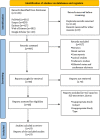Management of Iatrogenic Medial Collateral Ligament Injury in Primary Total Knee Arthroplasty: A Systematic Review
- PMID: 38577515
- PMCID: PMC10989723
- DOI: 10.22038/ABJS.2023.73563.3406
Management of Iatrogenic Medial Collateral Ligament Injury in Primary Total Knee Arthroplasty: A Systematic Review
Abstract
Objectives: The medial collateral ligament (MCL) injury is one of the possible complications of primary total knee arthroplasty (TKA), which can lead to coronal-plane instability that requires surgical revision. Injured MCL can result in joint instability and polyethylene wear. Different strategies have been proposed for MCL reconstruction based on the location of the injury. However, there is a lack of clarity regarding the optimal method for handling an iatrogenic MCL injury throughout a TKA.
Methods: A PRISMA flow diagram was used to guide the systematic literature review. An extensive search was conducted in PubMed, Embase, Scopus, Web of Science, and Google Scholar. Newcastle Ottawa scale checklist was used to assess the methodological quality of the articles.
Results: A total of 19 qualitative studies, including non-cadaveric patients with MCL injury during TKA, were identified after analyzing the full text of the articles. All included studies were either retrospective, observational cohort or case series. A total of 486 patients were studied to gather information on the methods used to repair the MCL and their results. Most injuries arose in the tibial attachment, which surgeons mostly realized during the final stages of surgery. Used techniques can be categorized into three main groups: Primary repair, Repair with augmentation, and changing prosthesis characteristics.
Conclusion: This systematic review demonstrated that the most popular management of iatrogenic MCL injury was using suture anchors, staples, screws and washers, and more constrained prostheses. The proper method should be decided considering the site of the MCL injury.
Keywords: Arthroplasty; Iatrogenic mcl injury; Intraoperative complications; Intraoperative repair; Knee; Medial collateral ligament.
2024 © BY THE ARCHIVES OF BONE AND JOINT SURGERY.
Conflict of interest statement
None
Figures
References
-
- Leopold SS, McStay C, Klafeta K, Jacobs JJ, Berger RA, Rosenberg AG. Primary repair of intraoperative disruption of the medical collateral ligament during total knee arthroplasty. J Bone Joint Surg Am. 2001;83(1):86–91. - PubMed
-
- Siqueira MB, Haller K, Mulder A, Goldblum AS, Klika AK, Barsoum WK. Outcomes of Medial Collateral Ligament Injuries during Total Knee Arthroplasty. J Knee Surg. 2016;29(1):68–73. - PubMed
Publication types
LinkOut - more resources
Full Text Sources

